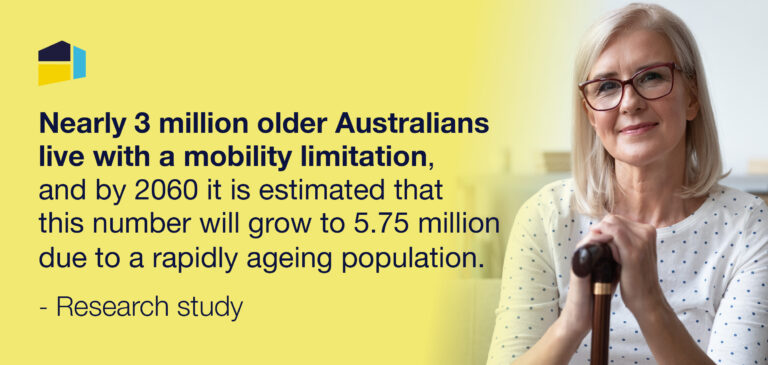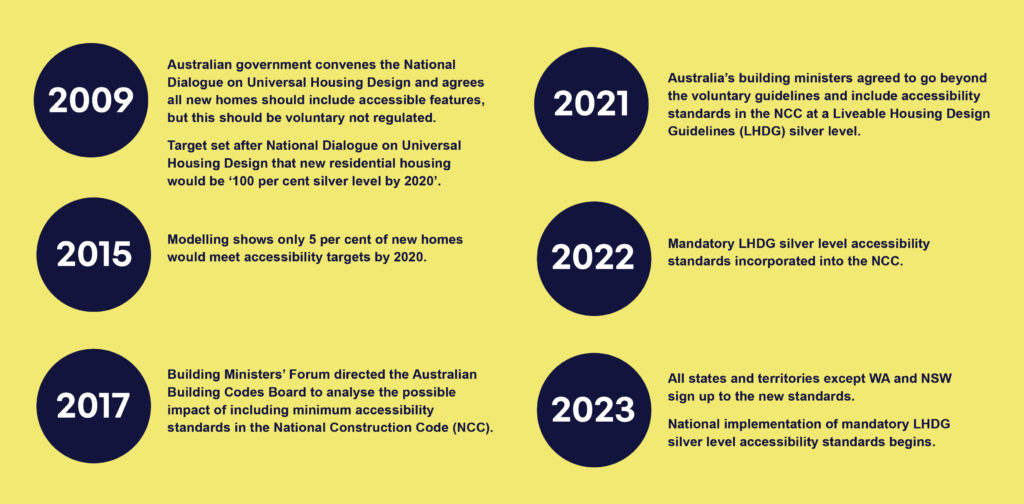
Accessibility features in new homes are good for everyone – for older people, for those with mobility issues, young families using prams, and for visitors to your home.
New research conducted by the Summer Foundation and Latrobe University investigated what support the design and construction sector needs to implement the mandatory minimum accessibility standards.
The design and construction professionals involved in the research identified what they valued about accessibility standards. These include the growing momentum from many years of campaigning for the standards to become mandatory, the equity benefits, and increasing awareness that accessible housing is for everyone at any life stage.
Builders, developers, architects and access consultants identified what practical support they need from governments and their industry bodies to successfully implement the standards as outlined in the 2022 National Construction Code (NCC).
The journey to mandatory accessible standards
The shortage of accessible housing has been a persistent and ongoing problem in Australia. As detailed in the research, initial moves in Australia to include voluntary minimum standards in the NCC were unsuccessful. Despite the Australian Government setting a target in 2009 that all new residential housing would be ‘100 percent silver level by 2020’ in 2015 modelling showed only 5% of homes would meet accessibility targets by 2020.
On 30 April 2021 Australia’s building ministers agreed to go beyond the voluntary guidelines and include accessibility standards in the NCC at a Liveable Housing Design Guidelines (LHDG) silver level¹. The amended NCC was adopted in September 2022 after which a transition period exists until 1st May 2024. However, the governments of New South Wales and Western Australia have yet to sign up to the accessibility provisions.
A summary of the key dates in the journey from voluntary to mandatory guidelines is in the following diagram²:

What are the mandatory accessibility requirements for new homes?
There are 7 standards in the Liveable Housing Design Guidelines silver level accessible design features.
LHDG silver level accessible design features
- A safe continuous and step free path of travel from the street entrance and/or parking area to a dwelling entrance that is level
- At least 1, level (step-free) entrance into the dwelling
- Internal doors and corridors that facilitate comfortable and unimpeded movement
between spaces - A toilet on the ground (or entry) level that provides easy access
- A bathroom that contains a hobless shower recess
- Reinforced walls around the toilet, shower and bath to support the safe installation of grab rails at a later date
- Stairways designed to reduce the likelihood of injury and also enable future adaptation
What’s next
Informed by this research, governments and industry bodies need to work to support the design and construction industry to implement the mandatory accessibility requirements for new homes, with a joined up cross-industry approach.
- All Australian governments commit to:
- National adoption of the standards, through Western Australia and New South Wales signing up to the standards
- Measuring the impact of the reforms on the supply of accessible housing and the benefits for consumers
¹ Commonwealth Government (2021). Building ministers’ meeting: Communique April 2021. https://www.industry.gov.au/news/building-ministers-meeting-communique-april-2021
² Liddicoat, S., Winkler, D., D’Cruz, K., Wellecke, C., Mulherin, P., & Douglas, J. (2024). Supporting the design and construction sector to transition to minimum accessible standards in new homes: A qualitative study. Summer Foundation. p. 8
